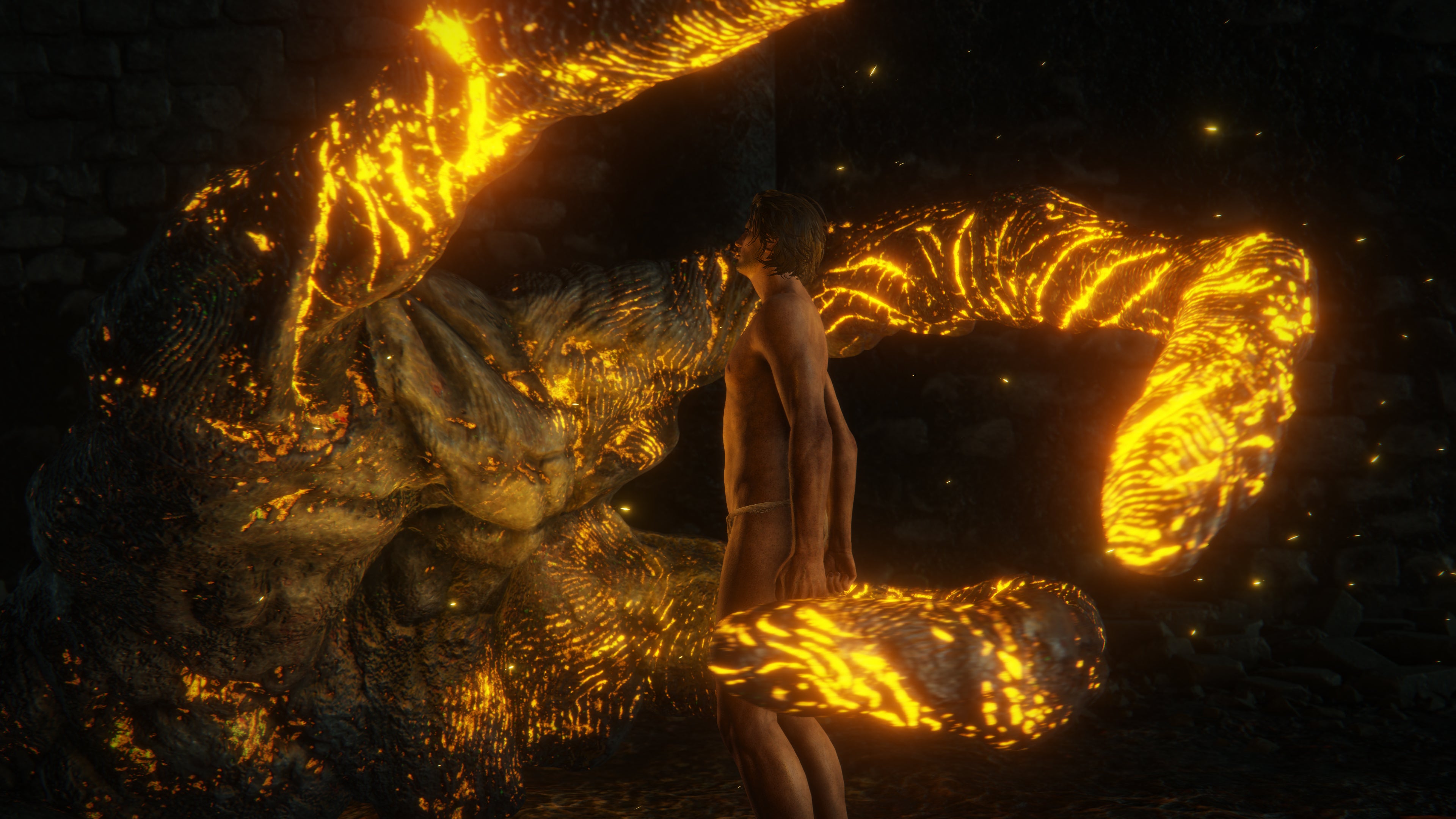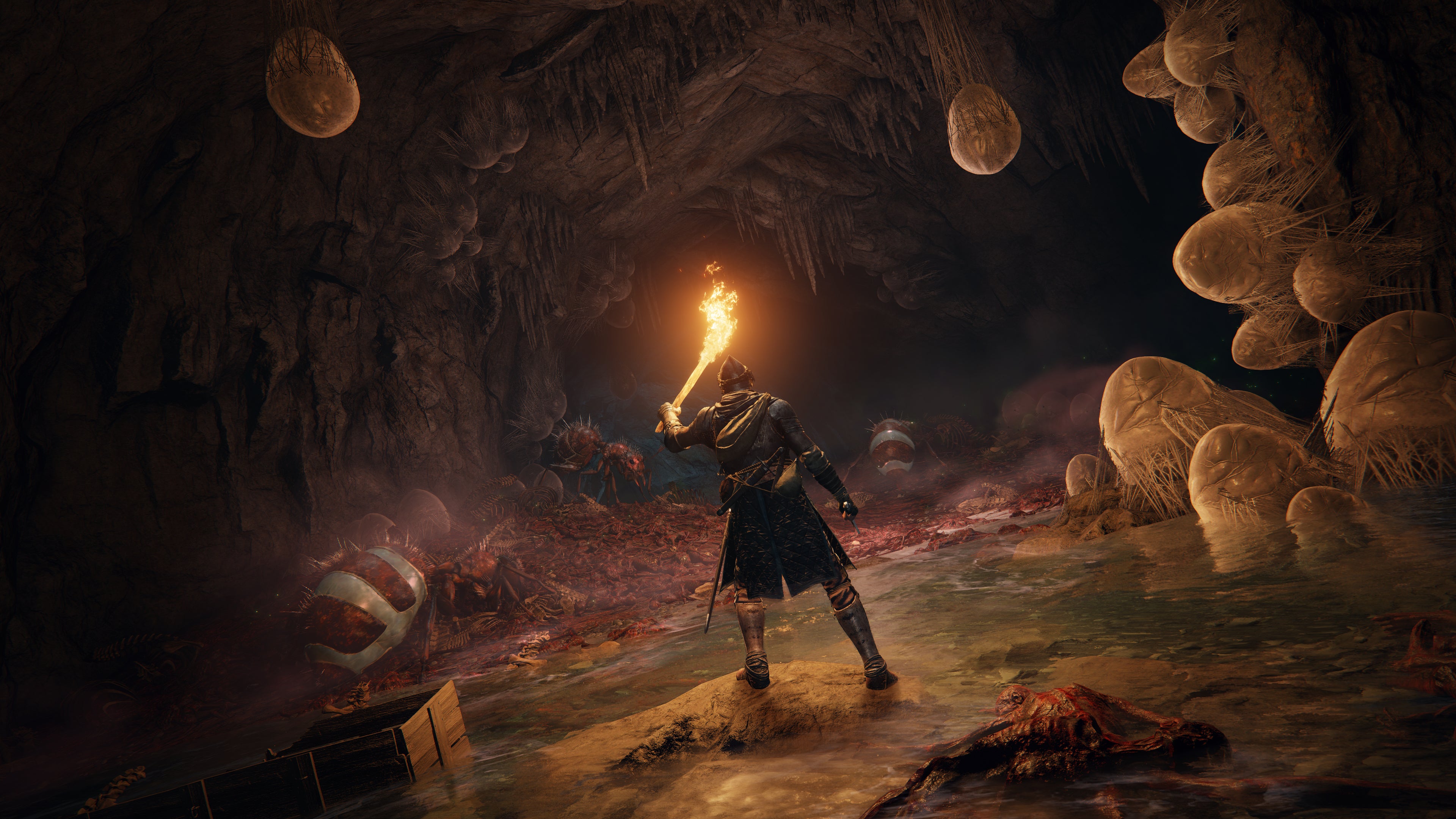FromSoftware’s new RPG drops you in a wide open world with zero overt direction. When you step into Limgrave in The Lands Between for the very first time, your eye will immediately be drawn to several points of intrigue. There’s a rocky beach to your left, a mounted warrior patrolling in front of a looming forest in front of you, ruined shells of buildings to your right, and a swamp complete with a vindictive dragon right behind you, all of which will take a good few minutes to stroll over to. Who knows what you might uncover in these areas, ripe for exploration? You might find a Point of Grace, Elden Ring’s version of Bonfires which are mercifully plentiful, an NPC that’ll marvel at your discovery of them and ponder what it is exactly that you’re doing here, or a group of armed warriors who’ll converge to kick your teeth in. The point is, all of these areas in Elden Ring’s opening moments - from the ruins, the cove, and the swamp - are immediately accessible and open to you, and it’s up to you where to explore. That’s overwhelming in the best sense. Contrast it with the start of Bloodborne, for example. FromSoftware’s gothic 2015 action game birthed the player into the middle of the city of Yharnam, giving you zero avenues of exploration outside of a single street, lined with vicious townsfolk and bloodthirsty dogs, chomping at the bit to rip your throat out. If you got stuck on that debut corridor - as I did for many days - Bloodborne shrugged and left you to bang your head against the wall, but in Elden Ring there’s a feeling that your place in the world, and your direction, is yours to control. If you get stuck in one area, just find somewhere else to explore. Elden Ring’s Limgrave feels immediately more open and inviting than perhaps anywhere FromSoftware has ever designed. The vast expanse of the open-world map goes hand in hand with the new spectral steed, which can not only double jump like it just departed from a platformer, but can race around the map and catapult you up to out-of-reach areas, making you feel a bit bigger in this huge map. Mounted combat is a bloody frenzy, with you and another warrior on horseback violently swinging at each other in a crazed joust, but it’s just another opportunity and play style that Elden Ring is all too happy to hand you. Elsewhere in combat, things will feel a little more familiar to FromSoftware veterans. There’s a limited stamina bar to work with, for example, offering you a precious amount of dodges and attacks in combat, and a short FP bar, Elden Ring’s magic meter by which you cast spells. What’s a little bit surprising is that Elden Ring’s dedicated jump button barely factors into combat at all, with a simple death-from-above attack the only avenue of aerial assault. Sekiro: Shadows Die Twice also featured a dedicated jump button, which factored into combat when the titular Shinobi leapt over an outstretched enemy attack, but here, in the early hours of Elden Ring at least, the jump button feels more geared towards exploration than it does combat. Elden Ring also fosters many of the same ‘play styles’ that past FromSoftware titles bore. There’s your standard Warrior, primed for swinging around multiple swords in unison, the Prophet, who casts spells and enchantments on foes and allies alike, and an Enchanted Knight, a cocktail of the two. There’s also the Bloody Wolf, a combat specialist that’s adept in parrying with a hefty shield, and finally the Champion, a shredded brawler who even enemies will want to stay well out of the reach of. All of these are offered in presets in Elden Ring’s technical test, with zero options in the way of customization. What’s brilliant is how these characters work off one another in co-op. Elden Ring allows for three players to team up at once, the joint-biggest number of allied players a ‘SoulsBorne’ game has ever permitted, and the results are fascinating. A Bloody Wolf might lead the charge, while a Prophet hangs back and peppers a boss with ranged spells, while a team of an Enchanted Knight and Warrior might take turns drawing the ire of a boss while the other sneaks behind it for a quick stab in the back. This is how things worked in the technical test’s final boss, Margit the Fell Omen - the creepy, multi-armed monstrosity from the 15-minute gameplay reveal. Our team of a Warrior, Prophet, and Bloody Wolf strayed a little too close to the grand entrance of Stormveil Castle, and Margit felt the need to drop down and beat the shit out of us. As expected, the Bloody Wolf got aggressive instantly, while the Prophet hung back to cast enchantments, and the Warrior lurked just out of reach of Margit, ready to dash in and react in a split second. An increased number of players didn’t diminish the boss at all, and Margit was still capable of sending any of us to an early grave with a well-placed attack. We reacted to the needs of each other without a single word passing between us. If the Bloody Wolf mistimed a dodge and got beaten to within an inch of their lives, the Warrior would step in to draw the ire of the boss while the former backed away for a heal, and the Prophet would cast a healing circle if they noticed either one of us were out of healing items and low on health. FromSoftware has found a great way for players to stop and consider who they’re summoning into their game, and why, instead of hitting proceed on any old player. On the other hand, fighting solo is a perfectly viable option. Just as Sekiro forced a solo world and brutal boss battles on its players without help from others, Elden Ring’s bosses and world are a challenge surmountable by yourself. It’ll take even more patience, combined with an ability to adapt on the fly and learn enemy attack patterns, sure, but when hasn’t any boss in a FromSoftware game required this? Elden Ring might offer three-player co-op, but it thankfully doesn’t stipulate it as an absolute requirement for overcoming the toughest foes. It’s undoubtedly early hours for Elden Ring, but it’s already shaping up to be something special, even by FromSoftware’s lofty standards. The same electrifying cut and thrust of combat is there as always, combined with fantastic new aspects like open-world exploration and a sense of freedom for an enticing new formula. Elden Ring is doing many things differently to the Souls games of the past, like four-player parties and mounted combat, but it feels like it’s taking careful consideration with how to integrate each one. There’s already a feverish hype surrounding Elden Ring, and this demo will only embolden that feeling with launch just three months away.


